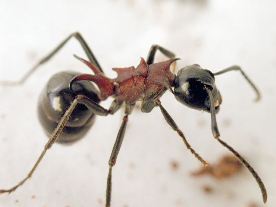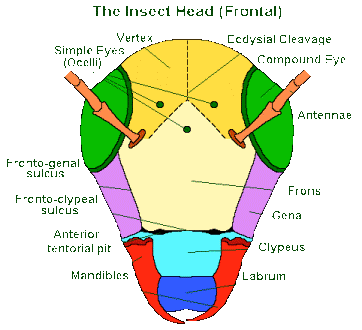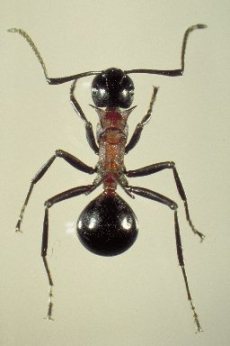Evolutionary Adaptations
How has it adapted
to its environment?
The Polyrhachis
lamellidens has acquir ed many adaptive
traits through its evolution that have permitted
it to achieve great success in its environmental
surroundings. The evolution of the large spines
on the petiole and propodeum regions have
provided these ants with an excellent defense
structure in a very vulnerable area for the ant.
The propodeum is a very thin part of the ant
that can easily be “sliced” by predators, which
would result in a lethal injury to the organism.
The evolution of these large spines provides the
organism with a means of defense to help prevent
such an injury from occurring.
ed many adaptive
traits through its evolution that have permitted
it to achieve great success in its environmental
surroundings. The evolution of the large spines
on the petiole and propodeum regions have
provided these ants with an excellent defense
structure in a very vulnerable area for the ant.
The propodeum is a very thin part of the ant
that can easily be “sliced” by predators, which
would result in a lethal injury to the organism.
The evolution of these large spines provides the
organism with a means of defense to help prevent
such an injury from occurring.
Evolution has also
provided the Polyrhachis lamellidens with
the ability to weave their own nests using
larval silk. This adaptation is an
important means of survival for the organism,
because it allows the ant to construct a safe
and durable nest in the trunks of hollow trees.
The larval silk nest provides members of the
colony with a safe place to live and the means
to fit into its niche.
One of the structures that varies the most within the Formicidae are the mandibles. The mandibles of the Polyrhachis lamellidens have evolved into fairly large triangular shapes. This morphology is important to omnivorous ants, because they need to be able to grasp their food and squeeze the juices from it in order aquire nutrients.
Primary means of
movement
 This organism
is very
motile and is able to move at a very fast pace
relative to its size. It is able to
achieve such movement through the use of six
legs that are attached to the thorax. The
legs of the Polyrhachis lamellidens are
very long relative to its body size, which
contributes to its ability to move so quickly.
The queen ants and the reproductive males are
also able to move using a pair of wings during
nuptial flight.
This organism
is very
motile and is able to move at a very fast pace
relative to its size. It is able to
achieve such movement through the use of six
legs that are attached to the thorax. The
legs of the Polyrhachis lamellidens are
very long relative to its body size, which
contributes to its ability to move so quickly.
The queen ants and the reproductive males are
also able to move using a pair of wings during
nuptial flight.
Sensing the
Environment
The two bent antennae
located on the head region of the ant are its
most important means of sensing the world around
them. The complex sensillum structures on
the antennae allow the Polyrhachis
lamellidens to use  chemical signals as a way
of achieving a greater level of organization in their colonies. These chemical signals are
vital to their survival as it allows them to
detect predators and prey. The antennae
are also important in that they provide the ant
with the ability to smell and detect sound.
chemical signals as a way
of achieving a greater level of organization in their colonies. These chemical signals are
vital to their survival as it allows them to
detect predators and prey. The antennae
are also important in that they provide the ant
with the ability to smell and detect sound.
The two compound eyes
located on the head region also help the ant
sense the environment. These large eyes do
not provide the ant with very good resolution,
but they do give the ant an acute perception of
movement with multiple images per eye.
Reacting to the
Environment
When the antennae and
compound eyes are used in accordance with one
another, this organism can be quite proficient
in reacting quickly to its environment.
The antennae allow the ant to sense when a
predator is approaching. It then relies on
the compound eyes for quick detection of that
predator and a hopeful escape.
The antennae are also
the reason for its ability to survive and live
in colonies. Worker ants react to signals
given by the queen to build a nest or to get
food. Without the antennae the ant would
not be able to detect or react to various
stimuli in the environment and within its
colony.
How do its
structures relate to their function?
The antennae are long
and slender in order to achieve maximum surface
area. When the surface area of the
antennae is greater, the capacity to sense the
environment increases. The antennae are so
vital to the survival of this organism that they
have developed combs on the “wrists” of their
appenda ges.
These comb structures allow them to keep their
antennae clean and functioning at their full capacity.
ges.
These comb structures allow them to keep their
antennae clean and functioning at their full capacity.
As mentioned above,
the compound eyes do not provide the organism
with images of great resolution. The
compound eyes of the ant take up a much greater
percent of the head than the eyes of humans and
other vertebrates do. The
compound eyes are not all that impressive
compared to most vertebrates. This is the
reason why increasing the surface area of their
eyes was a necessary evolutionary step. The
increased surface area of the compound eyes
allow the organism to possess a more effective sense
of sight.
The structure of the
spines on the petiole and propodeum are fairly
obvious in their function. The spines are
very long and sharp which allow for effective
protection against possible predators. The
two spines located on the petiole are the
longest and sharpest, because the area around
the petiole is where this ant is most vulnerable
to an attack.
Watch how the Polyrhachis lamellidens uses its antennae to sense the environment in this cool video! (skip to 0:30 to see antennae use)
Click here to move on to the Nutrition page
This link will return you to my home page.